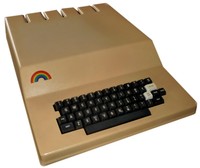Compukit UK101 (2)
| Home > Browse Our Collection > Computers > Compukit > Compukit UK101 (2) |
|
Made in the UK by Compukit in New Barnet, North London, the Compukit UK 101 was a single-board computer that you could buy as a kit or ready-made for an extra fee. The Compukit UK 101 retailed for £219 +VAT. Full constructional details were featured in Practical Electronics magazine, starting in the August 1979 issue. The UK101 was originally a copy of the Ohio Scientific Superboard II single-board computer. The hardware was designed by Dr Anthony Berk for Compshop, who had asked him to design a kit similar to the Superboard, which could be produced in the UK. The software was adapted by Andy Fisher from Compshop. The UK101 featured a few enhancements for the UK market - notably replacing the 24x24 (add guardband kit to give 32x32) screen display with a more useful 48x16 layout working at UK video frequencies. The video output was black and white with 256 characters generated by a 2K ROM. It had no bit-mapped graphics capability. The video was output through a UHF modulator, designed to connect to a TV set. The VDU controller has 1K of memory-mapped RAM and an ASTEC UHF modulator with co-axial socket into which your TV aerial may plug directly. The VDU will display up to 16 lines of 48 characters. When using Basic, the line width could be set to any value between 16 and 48. Compukit advised users to normally set the width to 46 as the last two characters would be lost from the edge of the screen if you attempted to display 48 characters to a line. In common with other home computers of the time, software could be saved and loaded on standard cassette tapes. I/O was managed by a Motorola 6850 ACIA. This allowed a full RS232 port to be implemented, with the addition of a few extra components and minor modifications to existing jumpers on the board. The 40 pin expansion socket opened up the world to the UK101. It also mated with all Superboard extras. One could attach a dual 5.5-inch floppy disk controller and a memory expansion card (40K max) to allow faster and reliable save/load of programs/data. Later on Compshop recommended not using discs with the UK101. The original intention was to use Ohio Scientific discs, however they were made to work with the original version but did not work with later versions. The kit came in a cardboard briefcase, in which there were anti-static tubes containing the 65+ ICs, a box of IC sockets, and bags containing passives (mainly 0.1uF ceramic decoupling capacitors) and keyboard bits (the keyboard switches were soldered directly to the PCB). This example of the UK 101 is mounted in a proprietary box. This item was kindly donated to us by Craig Cruickshank. Manufacturer: Compukit Comment on This Page Compukit UK101 (2) Manuals:
This exhibit has a reference ID of CH20372. Please quote this reference ID in any communication with the Centre for Computing History. |
Click on the Image(s) For Detail
|












